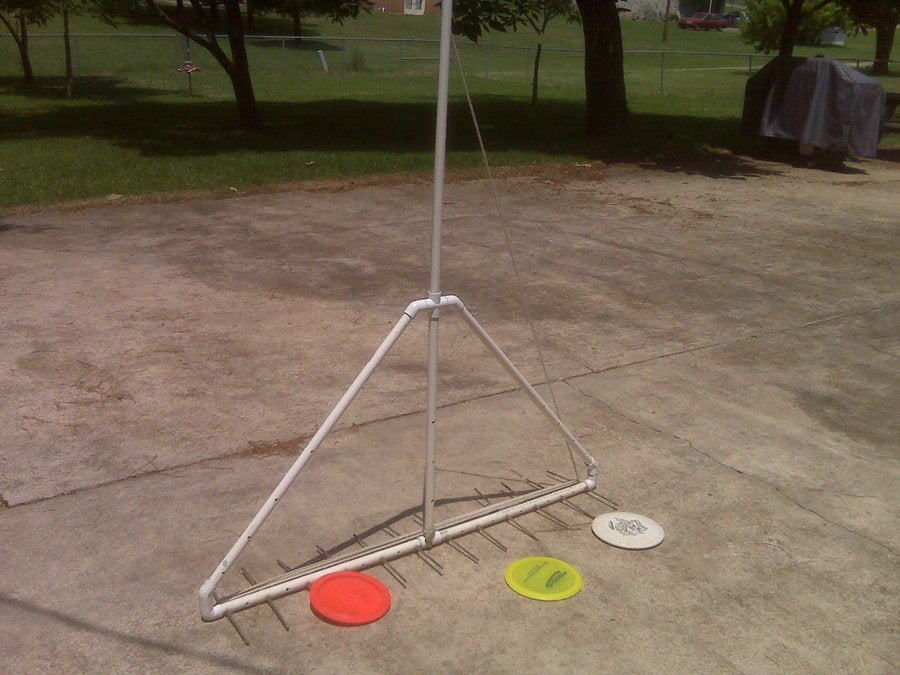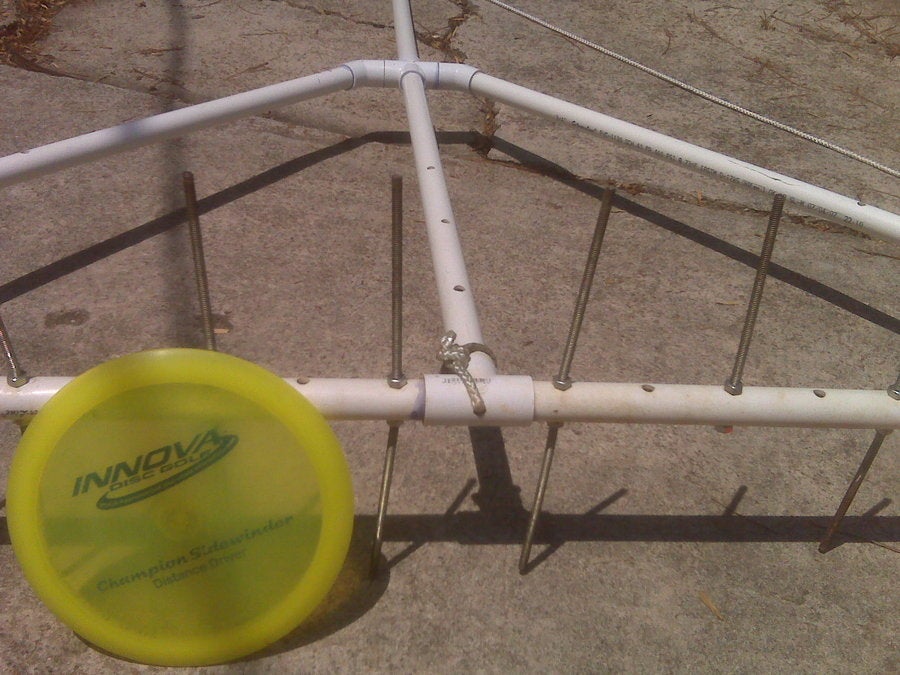Randy Sharp
Newbie
- Joined
- Dec 4, 2008
- Messages
- 21
For about $30, you can build a solid lake rake with common materials found at your local home improvement or hardware store. I've pulled hundreds of discs out with mine, sometimes two and three at a time!
I can toss my rake about 40 feet out. Good fishing!
Materials:
1 - 1/4" x 50' rope
2 - 3/4" PVC pipe x 10 ft.
1 - 3/4" PVC Tee
1 - 3/4" PVC Cross
4 - 3/4" PVC 45° Elbow
2 - 3/4" PVC 90° Elbow
1 - Sm. can pipe glue
12 ft. - 3/8" threaded rod (4 pc. at 36")
24 - 3/8 nuts
Use the pictures provided below as an assembly guide.
Measurements:
- Threaded rods are 12" long. Nuts are tight enough to hold the rod in place, but be careful. Over tightening could result in breaking the pipe.
- Length of cross piece holding rods is 51".
- Handle pieces are 26" each.
- Two angle braces are approx. 34" long. THESE ARE THE LAST PIECES CUT TO INSURE PROPER LENGTH.
Notable tips:
- DRILL HOLES SLOWLY AND CAREFULLY TO AVOID BREAKING THE PIPE.
- Drill 3/8" holes for rods 4.5" on center. Drill additional holes between the rods and along the lower angle pieces to allow the rake to fill with water, so it will sink.
- Rope MUST go through both ends of the rake. Tie one end around the Tee. The purpose is to make sure the rake doesn't get lost if a glued joint fails, or the rake hangs on something underwater. You may bend a rod if you get hung up, but the rake will not be lost.



Fishing Tips: Allow the rake to settle to the bottom, then pull at a steady and smooth rate of about 1 foot per second. When combing an area, overlap your throws by half the rake width. Believe me, you'll increase your find!
From experience, the disc will "flip up" on its edge once the rake tine hits it. The water pressure will hold it in place against the tines. In rare cases, the tine will catch the lip of an upside down disc and drag it to the bank.
The best areas to fish are those with open bank areas. I usually work about 75 feet from the pin to about 50 feet past it.
Avoid areas under trees that may have shed large limbs and massive beds of leaves, or have lilly pads and cat tails. These areas are a pain. All you end up doing is raking debris.
I can toss my rake about 40 feet out. Good fishing!
Materials:
1 - 1/4" x 50' rope
2 - 3/4" PVC pipe x 10 ft.
1 - 3/4" PVC Tee
1 - 3/4" PVC Cross
4 - 3/4" PVC 45° Elbow
2 - 3/4" PVC 90° Elbow
1 - Sm. can pipe glue
12 ft. - 3/8" threaded rod (4 pc. at 36")
24 - 3/8 nuts
Use the pictures provided below as an assembly guide.
Measurements:
- Threaded rods are 12" long. Nuts are tight enough to hold the rod in place, but be careful. Over tightening could result in breaking the pipe.
- Length of cross piece holding rods is 51".
- Handle pieces are 26" each.
- Two angle braces are approx. 34" long. THESE ARE THE LAST PIECES CUT TO INSURE PROPER LENGTH.
Notable tips:
- DRILL HOLES SLOWLY AND CAREFULLY TO AVOID BREAKING THE PIPE.
- Drill 3/8" holes for rods 4.5" on center. Drill additional holes between the rods and along the lower angle pieces to allow the rake to fill with water, so it will sink.
- Rope MUST go through both ends of the rake. Tie one end around the Tee. The purpose is to make sure the rake doesn't get lost if a glued joint fails, or the rake hangs on something underwater. You may bend a rod if you get hung up, but the rake will not be lost.



Fishing Tips: Allow the rake to settle to the bottom, then pull at a steady and smooth rate of about 1 foot per second. When combing an area, overlap your throws by half the rake width. Believe me, you'll increase your find!
From experience, the disc will "flip up" on its edge once the rake tine hits it. The water pressure will hold it in place against the tines. In rare cases, the tine will catch the lip of an upside down disc and drag it to the bank.
The best areas to fish are those with open bank areas. I usually work about 75 feet from the pin to about 50 feet past it.
Avoid areas under trees that may have shed large limbs and massive beds of leaves, or have lilly pads and cat tails. These areas are a pain. All you end up doing is raking debris.